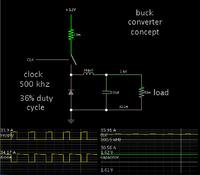vinayakdabholkar
Advanced Member level 4
someone please help me with this ckt. This is a synchronous buck converter. The first pdf(up1) is my circuit diagram
When i do not connect the filter and take the output directly at the source of the top switch i get the graphs as in the second pdf(up3) with an average voltage of more than 3V.
But when i connect the filter across it ,the average voltage is not even 1V ,3rd pdf(up2). Whats the problem with this
My specifications used are
Vin=12v, Vout=1.6V ,D=0.133,Fs=500K,Iload=130A,Iripple=39A(30% of Iload),Vripple=10mV.
Please help , I am stuck because of this.
When i do not connect the filter and take the output directly at the source of the top switch i get the graphs as in the second pdf(up3) with an average voltage of more than 3V.
But when i connect the filter across it ,the average voltage is not even 1V ,3rd pdf(up2). Whats the problem with this
My specifications used are
Vin=12v, Vout=1.6V ,D=0.133,Fs=500K,Iload=130A,Iripple=39A(30% of Iload),Vripple=10mV.
Please help , I am stuck because of this.
